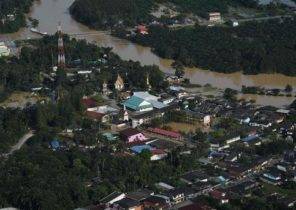Since September 2019 specialists in the study of the history of the middle ages lead to a heated debate about the term “Anglo-Saxon”. These disputes commenced in connection with allegations of racism and sexism within the International society of researchers of the Anglo-Saxon period (International Society of Anglo-Saxonists), a scientific organization specializing in the study of history, archaeology, literature, language, religion, social system and numismatics of early medieval period (ad 450-1100). Some scholars have argued that the change of name of this society will be a step towards eliminating racism and sexism, particularly in how scientists study and interpretiruya earlier middle ages.
Very quickly the focus of discussion has shifted from the need to remove the term “Anglo-Saxon” from the name of the society [now called the organization the International society for the study of England’s early medieval period (International Society for the Study of Early Medieval England)] to statements about what to do to stop using the term “Anglo-Saxon England” to refer to parts of the territories of great Britain in the period from the middle to the end of the first Millennium of our era, and the term “Anglo-Saxon world” to refer to relations of this region with Europe of the early middle ages and other regions.
Very quickly this campaign has led to the fact that anyone who did not agree with these changes, getting labeled “racist”, and anyone who tried to make additional reservations who were trying to amend or challenge the foundations and installation of the debates, called a supporter of the racist use of the term “Anglo-Saxon”. Online declarations stated that scientists should demonstrate their willingness to change, striking out the term “Anglo-Saxon” of scientific papers and courses and refusing to cooperate with those scientists who want to continue to use this term.
I like an archaeologist, specialized in great Britain and Scandinavia during the early middle ages, consider it necessary to retain this term in the studies of material culture created by the environment and landscapes of the early medieval period, as well as in public speaking and education. Those who argue that the terms “England in the early middle ages” and “ancient Britain” are more accurate and are not burdened with unnecessary racist connotations, simply do not understand the peculiarities of the use and abuse data relevant to the early middle ages.
There is no doubt that the term “Anglo-Saxon” really like racists and political movements supremacy of the white race, especially in North America. But I believe that the preservation and continued use of this term in scientific discourse, public life and education is the best way to protect against attempts of racists to appropriate it and to abuse it for the sake of achieving their goals.
***
Underlying the current dispute lies partly controversial past such terms as “Anglo-Saxons” and “Anglo-Saxon England”. Like “Vikings” and “the Celts”, these terms for a long time attracted people and groups adhere to a racist ideology, especially those who focus on myths of national origin. In distorted interpretations of the past Britain has been inhabited in the V century of our era German migrants pushed the indigenous tribes. They were freedom-loving farmers and soldiers, at first pagans, then Christians, defending ancient freedoms and fought against the bloodthirsty Vikings, but ultimately found themselves under the “Norman yoke.” Nationalists and racists often appealed to this persistent romantic image of a small England, to justify British nationalism, as well as foreign colonial and Imperial missions. In the United States “anglosaxons” is the preferred term white supremacists. From the point of view of those British and American nationalists, imperialists, and supremacy of the white race, the term “Anglo-Saxon” means direct belonging to the “Golden age” and captures the essence of all that ensures the superiority of England (and consequently Britain).
The last few years, representatives of the gaining momentum of alternative right-wing populism, ethno-nationalism and white racism began to use the early middle ages as a political symbol. As a result, scientists specializing in the early middle ages, found that the literature, art and archaeological finds on which they rely in the studies used various xenophobic and chauvinistic political groups in their own interests. Meanwhile a commercial company offering various DNA tests and popular television programs perpetuate pseudoscientific stereotypes about Anglo-Saxons and the Vikings.
In response, some scholars have pointed to the danger of claiming that any use of ethnic terms, including the term “Anglo-Saxon”, promotes the dissemination of racist myths about the past and close access for professionals of non-European origin. However, in November 2019, under pressure from the alarmed group of scientists of the International research society for Anglo-Saxon period, voted to change its name to the International society for the study of England’s early medieval period. They decided that a name change will help them to reduce the degree or even to confront the alleged “white”, sexism and elitism studies of Anglo-Saxon culture. After this, the term “Anglo-Saxon” began to gradually disappear from the titles of University courses, books, scientific articles and conferences.
Despite many warnings, experts on literature and language, agreed to the changed terms, not wanting to take into account the results of archaeological research. Like all the Sciences and the Humanities, archaeology bears the burden of imperialist and colonial past. Moreover, it has long been in conflict with the sustainable “fake” interpretations of having a racist motivation from the stories of ancient aliens to myths about national origin. However, archaeology is very popular worldwide among people of all generations, because it is directly connected with the images of adventure and discovery. For many people, the “Anglo-Saxon” places, monuments and objects of material culture are ready — made gates, especially in the United Kingdom, in the rich and intricate history of the early middle ages.
Thus, although my research is devoted to a critical assessment of the history of medieval archaeology and attempts to rethink the archaeology of funerary rites the same time, I support to proceed with caution to use the term “Anglo-Saxon” and thus to hinder the attempts of the ethno-nationalists and white supremacists to use it to their advantage.
***
Currently, when researchers and teachers are saying about the “Anglo-Saxons” and “Anglo-Saxon England”, they don’t mean some “racial” group. This term even refers to one specific phenomenon, and encompasses seven centuries of change and very different kingdoms and communities from Kent to Cumbria, from East Anglia to the borders of Wales. After the collapse of the Roman Empire and the end of the reign of the Romans in the British Isles in the early fifth century ad through the North sea, there came a variety of barbarian tribes that arrived from the territory of modern Norway and Northern Netherlands and settled in lowland Britain. Bede (Venerable Bede) described these tribes in his writings the beginning of the VIII century of our era, calling them “the angles, Saxons, and yutami”.
Migration is a process that takes place over many generations and which is based on ethnogenesis, and not ethnic replacement. The political and economic situation is constantly varied and was unstable. In addition, in those areas remained Romano-Briton population. Descendants of kanteev, the Iceni, trinovantes and other tribes in Roman Britain, mixed with the Germanic migrants with different speed and under different circumstances. “Anglo-Saxon” kingdoms that arose in the late sixth century and converted to Christianity at different points in the VII century, had many complex relationships with the British kingdoms, which gradually developed to the North and West of them. In the VII century, these Anglo-Saxon kingdoms were seven, Kent, Sussex, Essex, Wessex, East Anglia, Mercia and Northumbria, and the beginning of the ninth century there were only four: Wessex, East Anglia, Mercia and Northumbria.
But in the ninth century arrived on the island by the Vikings destroyed all the Kingdom, except one — the Wessex. It zapadnoukrainskaya Kingdom was the basis for the United England of the tenth century. “Anglo-Saxon England”, which for the most part of the XI century was ruled by Danish kings ceased to exist with the arrival of the Normans in 1066. “Anglo-Saxon” is a convenient term to denote a complex social, economic, religious, linguistic and cultural processes that occurred in the period between the collapse of the Roman Empire and the invasion of the Normans. Like other names of epochs, this term is an interpretive tool used for the boundaries between individual age and the ages that preceded and followed it. However, this term carries a lot of restrictions in the sense of the description of diverse communities and landscapes.
The first known mention of the term “Anglo-Saxon” made in Italy, VIII century when Paul the Deacon used it in his “History of the Lombards”. This term has appeared regularly in written documents of that era — from documents relating to the reign of Alfred the Great (who died in 899 year), to stories about the deeds of Edward the Confessor (died in 1066), and was used to describe those kingdoms and kings.
The term “Anglo-Saxon” received new life only in the late eighteenth and early nineteenth centuries. Historians and scientists engaged in the study of language and literature, began to use it to identify the peoples who spoke Anglo-Saxon language, their kingdoms and relationships on the island of great Britain. They used this term to distinguish these peoples from the peoples who spoke Celtic language, from the settlers-Vikings who spoke old Icelandic language, from the Norman Kingdom, which arose in these areas later. Thus, the “Anglo-Saxon” raised in the early Victorian era as part of the process of the formation of the myth of national origin, and archaeology has become a key element of this political program.
The first archaeologists began to use the term “Anglo-Saxon” for their discoveries in the late 1840-ies. The aristocrat of Essex, sir Richard Cornwallis Neville (Richard Cornwallis Neville) have unearthed burial sites in little Wilbraham and Linton-Heath, and called them “Anglo-Saxon”. Neville believed these cemeteries in Cambridgeshire the evidence in these areas the first German settlers who arrived after the departure of the Romans. Work and terminology Neville determined characteristic of the era’s racist thinking and romanticized images of the birth of England. This term has been very influential and sustainable. When archaeologists of the early and mid-twentieth century made on the basis of finds of clay pots and ornaments, to trace the routes of the invasions of the Germanic tribes, they relied on the work of Neville and his contemporaries.
Meanwhile, in the field of Anglo-Saxon archaeology since 1960-ies and 1970-ies, a host of new questions that resulted from the influx of a huge number of new data. Implemented a new, more advanced methods of excavation, research and analysis of objects of material culture. Traditional issues remain hotly debated, including questions about the scale and nature of migration of the Germanic tribes, time and the nature of the formation of kingdoms, speed and value conversion to Christianity, as well as the extent of their resilience in the raids of the Vikings. However, to this list were added a lot of new questions and riddles relating to the Anglo-Saxon social structure and identity, political ideology, political system, economic activities and relations, land management and so on. Moreover, today the archaeologists specializing in the Anglo-Saxon era, maintain close ties with archaeologists working on similar issues in other parts of Europe and beyond, and they are actively involved in interdisciplinary dialogue.
As a result, the archaeologists use “Anglo-Saxon” as a term that conveys temporal and spatial scales, and the complexity and heterogeneity of early medieval settlement, cemeteries and material culture. This era is conventionally divided into early Anglo-Saxon period (V to early VII century ad), middle Anglo-Saxon period (late VII-early IX century ad) and late Anglo-Saxon and Scandinavian period (the end of IX until mid XI century BC) — for the sake of convenience. We also use the terms “post-Roman”, “late”, “island”, “early medieval”. All of these terms are as imperfect as the term “Anglo-Saxon”, but together they help us to transmit information on the time frame, the region, and (sometimes) the styles of those material findings that we can study.
When archaeologists say “the early Anglo-Saxon cemeteries”, “settlements of the middle Anglo-Saxon period”, “great Anglo-Saxon brooches”, “coins of the late Anglo-Saxon period”, these terms allow us to get an idea about the objects and subjects of when they were made or found. This term has no racial connotations. Invented modern racial categorization is simply not applicable to the early middle ages. Archaeologists sometimes use the term “Saxon” to denote the South of England, and in other cases they use the term “English”, referring to the East and North-East of England. The term “Anglo-Saxon” is used not only by scientists, but in popular culture and in education — from Museum exhibitions to open databases of archaeological finds.
***
Like most other disciplines, archaeology has inherited elements of racist and colonial past. However, the irony is that in the early Victorian era it is the possession of British overseas civilizations made the first generation of archaeologists in the Anglo-Saxon period, including Charles roach Smith (Charles Roach Smith) and of John Yonge Akerman (John Yonge Akerman), refer to the sources of England. Today Anglo-Saxon history and archaeology is widely taught in schools of the United Kingdom, their details are actively disseminated through television, social media, popular scientific literature, and every year millions of people visit museums and monuments of the Anglo-Saxon culture.
There are many passionate fans of this culture who seek in detail to restore all aspects of Anglo-Saxon life, for example, society Regia Anglorum in England. For many enthusiasts, lovers and religious groups (pagan and Christian) “Anglo-Saxons” are of great importance. For example, the detection and demonstration of the Staffordshire treasure in conjunction with the 1100 years anniversary of the death Ethelfleda Mansiiskoi, which is celebrated in 2018, caused a surge of pride among residents of the Central counties of England, focused on the Anglo-Saxon past. As shown by the article by Michael woods (Michael Woods), recently published in the journal Bi BBC History Magazine, as well as interviews with Bonnie Greer (Bonnie Greer) bi-Bi-si Radio 6, new communities of immigrants do not feel any discrimination in connection with the use of the term. In short, there are many ways that today allow people to experience and feel the history of the Anglo-Saxons in the absence of any hint of ethnic nationalism and racism.
Indeed, the last 30 years can be called a kind of “Golden age” of Anglo-Saxon archaeology, since there were many new discoveries and implemented many innovative projects on a number of topics. In particular, in my area, an area archaeological sites burials — we have revised our understanding of continuous transformation and continuous elements starting from the Roman period to the Middle ages. Instead of trying to identify the funerary objects from the ethnic groups of the past, experts in the field of funerary archaeology of the early Anglo-Saxon period open up new possibilities for the study of the life and death of people in the early middle ages. Scientists are studying these objects and materials to better understand gender relations, kinship and social memory. One of the obvious examples in this sense can become a long-term research projects at Sutton hoo in Suffolk that is being led by archaeologist Martin Carver (Martin Carver), as well as recent excavations of the cemetery Tranmere house. These excavations and research are changing our understanding of the strong links and funerary ideology of the Kingdom of East Anglia of the late VI and early VII centuries.
Collection of The Oxford Handbook of Anglo-Saxon Archaeology (2011), which included 52 articles, demonstrates the breadth and depth of the current approaches to research and topics from multiple levels of organization of settlements and hierarchies, craft technologies and their evolution to the changes in the perception of personality from infancy to old age. Meanwhile, in his 2013 book dedicated to the Anglo-Saxon graves and items that were placed in these graves, Alex Bailey (Alex Baylis) and her co-authors suggested a new chronology of the VI and VII centuries, demonstrating interdisciplinarity and innovative methods of modern Anglo-Saxon archaeology. In his detailed book 2019 Formative Britain (“the Formation of Britain”) Carver considers the Anglo-Saxon Kingdom in the broader context, exploring Wales, the South-West and the North of the UK and the Picts in particular. And the book Keith ray (Keith Ray) and Ian Bapty (Ian Bapty) called Offa’s Dyke (“Val Offa’s dyke”) is an example of a detailed analysis of a specific place, showing us that the longest and greatest monument of early medieval Britain was an expression of political ideology and hegemony, designed to stand out from the General landscape and to inspire fear in the opponents. Meanwhile, in his book 2019 The Sword in Early Medieval Northern Europe (“the Sword of Northern Europe in the early middle ages”) Branning sue (Sue Brunning), curator of the British Museum, considers how these belonged to the Anglo-Saxons and Vikings artifacts lived their own lives until they were worn, traded, demonstrated and placed in graves for the dead. All this works “is of Anglo-Saxon archaeology”, rich in ideas and data, and having a strong Foundation.
In addition, the term “Anglo-Saxon” became increasingly used in the context of cutting-edge research of international importance. The report of the Museum of London archaeology (Museum of London Archaeology), dedicated to the Royal burial in Southland-on-sea, is an example of high-quality archaeological research conducted by a commercial company, along with the popular scientific book published in 2019. In the same year he published a book The Staffordshire Hoard: An Anglo-Saxon Treasure (“Staffordshire treasure: the hoard of the Anglo-Saxons”), which elaborates on the elements of arms and other fragments of gold, silver and garnet, discovered in the Treasury, and widely publicized book about the excavations of the early medieval Anglo-Saxon cemetery at barrow-Clamp in Wiltshire.
Through participation in the excavation and digital methods of dissemination and exchange of information public archaeology Anglo-Saxon period, is experiencing unprecedented growth. Cooperation at the University of Durham and company Dig Ventures in the excavations reveals the Anglo-Saxon monastery at Lindisfarne, and their website invites us to “join the search for the heart of Anglo-Saxon Northumbria”. In addition, a large-scale study Catherine Jarman (Catrine Jarman) on the site of a monastery in Mercia and the site of winter camps of the Vikings at Repton in Derbyshire was widely reported in many Newspapers, in the scientific journal Antiquity, and even in a documentary called Britain’s Viking Graveyard (“Cemetery of the Vikings in Britain”). Such projects as the nominee based on comparison of the Anglo-Saxons and Vikings, to convey to people information about the precise differences between different archaeological finds. In addition, long-term project in Rendlesham in Suffolk, which was attended by both professional archaeologists and Amateurs with metal detectors led to the discovery of many interesting artifacts relating to the life of the Royal family in East Anglia. Public engagement has become an integral element in the implementation of this innovative research project, and now the national lottery heritage Fund (National Lottery Heritage Fund) is sponsoring four-year archaeological project called Rendlesham Revealed: Anglo-Saxon Life in South-East Suffolk (the”Rendlesham: the life of Anglo-Saxons in the South-East of Suffolk”).
Today, the public can freely access detailed information and analysis of archaeological finds of the Anglo-Saxon era through the Archaeology Data service at York University. People can get access to invaluable research resources related to the period in which the term “Anglo-Saxon” is used effectively and responsibly. An example is the Case of Anglo-Saxon stone sculpture (Corpus of Anglo-Saxon Stone Sculpture) in Durham, where you can find an extensive database of artifacts related to the early middle ages and is found in England, and detailed scientific descriptions.
Popular Anglo-Saxon archaeology and the public. Scholars such as Duncan Sayer (Sayer Duncan), much has been written about ancient DNA and funerary archaeology, and Kathleen green (Caitlin Green) writes a blog and tweets about the far limits of the Anglo-Saxon world. In museums throughout England you can get acquainted with the culture of the Anglo-Saxons, for example, in room 41 of the British Museum. In museums large and small cities you can find rich collections of the Museum are the archaeological finds relating to Anglo-Saxon culture, including the Museum in Norwich castle.
***
The term “Anglo-Saxon” has long been quite controversial, as political extremists used it in my old-fashioned, overly simplified and pseudoarchaeologists interpretations. Moreover, in different classrooms this term evokes different associations. Scientists are right, questioning his extra values. Undoubtedly, the term “Anglo-Saxon” is only one of a number of terms related to the early middle ages, which can cause potentially dangerous and deceptive racial and nationalist Association — other examples can be the terms “Celts”, “Germans”, “the Vikings” and so on. On the other hand, the term “Anglo-Saxon” has long lost its racist element that was characteristic of the nineteenth century. Modern archaeologists use it to describe objects of material culture, sites, monuments and topography, corresponding to the period from V to XI century ad, and it helps to give clear characteristics of the early middle ages. We are now experiencing the Golden age of Anglo-Saxon archaeology, and we should try to preserve the history of the era as accurately as possible instead of ignoring this fascinating period with many of his intriguing objects, monuments and landscape elements.
Exposing all those who use the term “Anglo-Saxon”, “racists”, the supporters of the rejection of the term risk alienate scientists, commercial archaeologists, cultural sector, interested communities, religious groups and enthusiasts, as well as potential future researchers. So instead of letting the “Anglo-Saxon England” to become a platform for extremists, populists, lovers of self-promotion and visionaries, we must continue to intensify efforts to research and interaction with the public, which will not leave room for false interpretations and will allow anyone to penetrate to the essence of the subject. Instead of “postglobalmessage melancholy”, in which we will have to start from scratch, not having the appropriate term, of Anglo-Saxon archaeology can continue to rebuild and to reassess its strengths, offering extensive original research and actively talking about them to the public.
This is why, together with 70 experts, I signed a joint statement and continue to publish articles in other journals, insisting that we must preserve and fight for the terms “Anglo-Saxons” and “Anglo-Saxon period,” challenging the academic and social misconceptions and abuses. In this sense, those who propose to replace the term “Anglo-Saxon” to “early English” or “old English” risk provoking the emergence of more opportunities for abuse than in the case of “Anglo-Saxons”. In particular, the term “English” does not allow to draw a line between language and ethnicity, between the past and the present, so apply this term in relation to archaeological finds and monuments will be at best a folly. I remain a supporter of a critical and cautious use of the term “Anglo-Saxon”, which is already well established that all understand, and which allows to describe complex and diverse material worlds, corresponding to the period from the middle to the end of the first Millennium. To paraphrase the motto of the Council for British archaeology, I advocate that Anglo-Saxon archaeology was made available to all.
Howard Williams is Professor of archaeology at the University of Chester in the United Kingdom.







